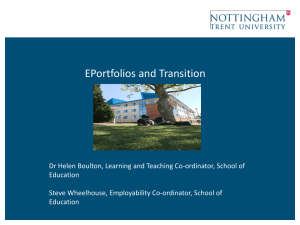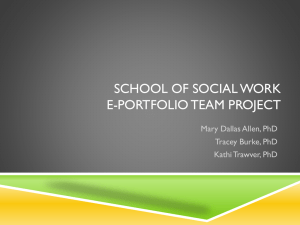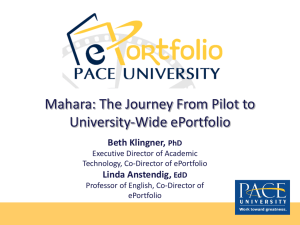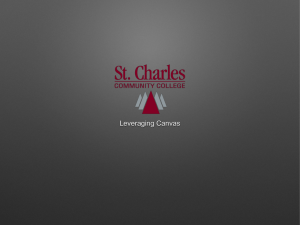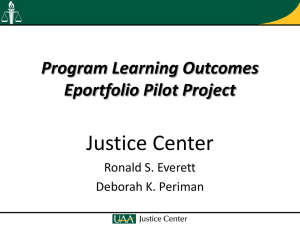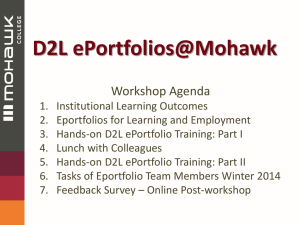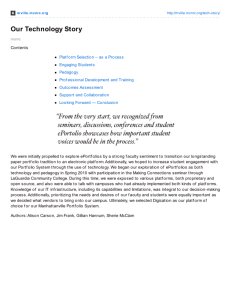April 2015 Advisory Committee Report - A-Portfolio
advertisement
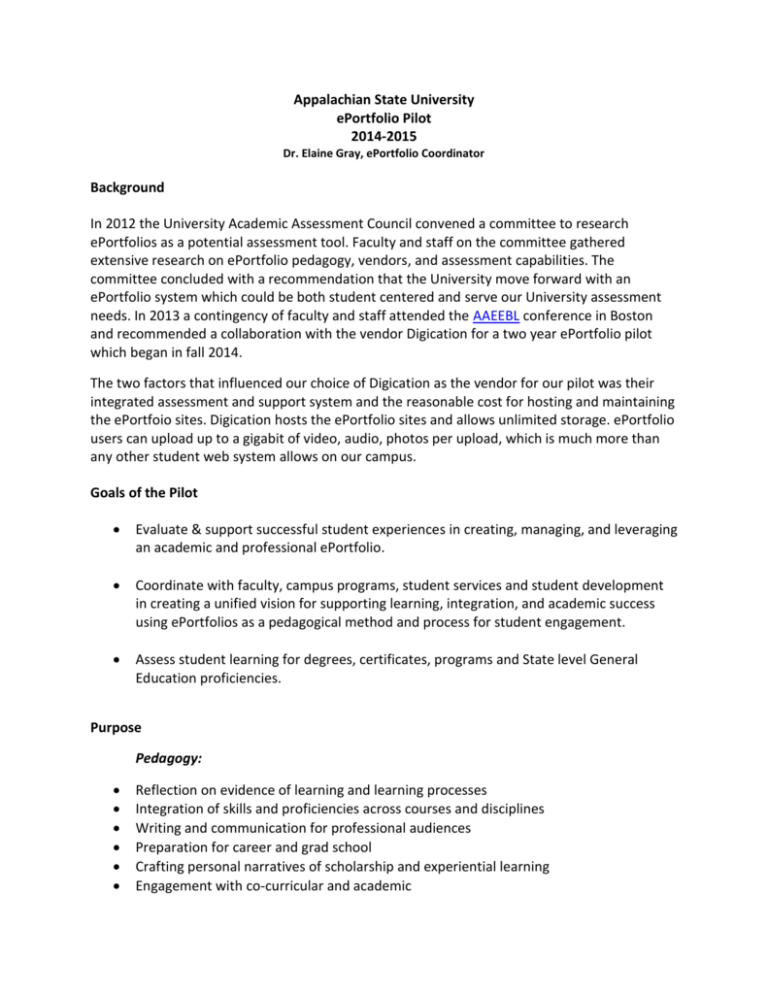
Appalachian State University
ePortfolio Pilot
2014-2015
Dr. Elaine Gray, ePortfolio Coordinator
Background
In 2012 the University Academic Assessment Council convened a committee to research
ePortfolios as a potential assessment tool. Faculty and staff on the committee gathered
extensive research on ePortfolio pedagogy, vendors, and assessment capabilities. The
committee concluded with a recommendation that the University move forward with an
ePortfolio system which could be both student centered and serve our University assessment
needs. In 2013 a contingency of faculty and staff attended the AAEEBL conference in Boston
and recommended a collaboration with the vendor Digication for a two year ePortfolio pilot
which began in fall 2014.
The two factors that influenced our choice of Digication as the vendor for our pilot was their
integrated assessment and support system and the reasonable cost for hosting and maintaining
the ePortfoio sites. Digication hosts the ePortfolio sites and allows unlimited storage. ePortfolio
users can upload up to a gigabit of video, audio, photos per upload, which is much more than
any other student web system allows on our campus.
Goals of the Pilot
Evaluate & support successful student experiences in creating, managing, and leveraging
an academic and professional ePortfolio.
Coordinate with faculty, campus programs, student services and student development
in creating a unified vision for supporting learning, integration, and academic success
using ePortfolios as a pedagogical method and process for student engagement.
Assess student learning for degrees, certificates, programs and State level General
Education proficiencies.
Purpose
Pedagogy:
Reflection on evidence of learning and learning processes
Integration of skills and proficiencies across courses and disciplines
Writing and communication for professional audiences
Preparation for career and grad school
Crafting personal narratives of scholarship and experiential learning
Engagement with co-curricular and academic
Providing insight for student advising and career guidance
Student Showcase:
Preserve and reflect on best work and products of learning
Create a positive digital presence
Provide an in depth web presentation of accomplishments
Assessment:
Link courses or program level learning outcomes to ePortfolio assignments and capture
snapshots of student learning
Sample, review and score student artifacts or products of learning within ePortfolios
using online rubrics mapped to standards or learning outcomes
Export assessment scores and metadata in standard CSV reports
Pilot Organizational Structure [See: http://aportfolio.appstate.edu/committees]
The Aportfolio Advisory Committee was convened by Cathy Bates (CIO) and Mike Mayfield (VP
Undergraduate Education) in January 2014. Elaine Gray was assigned half time release to serve
as the campus wide ePortfolio coordinator. The Aportfolio Advisory Committee formed several
working sub-committees that began the process of coordinating the campus-wide
implementation of ePortfolios. Sub-committees included Academic Programs, Student
Development, IT Implementation, Scholarship and Research, and Assessment.
The structure of the sub-committees was consolidated into working teams in January 2015.
The teams with responsibility for supporting the pilot are the IT implementation team, the
Assessment team and the Writing implementation team. The ePortfolio coordinator and a
graduate assistant developed training and documentation for faculty and students. [See
http://aportfolio.appstate.edu/support ]The ePortfolio coordinator reports to the Vice Provost
for Undergraduate Studies and the Chief Information Officer and serves as a liaison on
numerous university councils and committees while additionally coordinating assessment for
the General Education Program.
Campus Wide Aportfolio Pilot Participants
Fall 2014
First semester participation began with 11 courses, 23 faculty members and over 813 students
in 49 sections. [First Year Seminar, Second Year Writing, Geography and Planning , Chemistry,
Communications, College of Education]
Spring 2015
Second semester pilot continues with 17 courses, 25 faculty members and 929 students in 46
sections. [First Year Seminar, First Year Writing, Second Year Writing, College of Education,
Geography and Planning, Chemistry, Communications, Health and Psychological Counseling,
Geology, Appalachian Studies, Industrial Design, & English]
Fall 2015
The third semester of the pilot (fall 2105) will expand to include all active students from
previous two semesters, plus adding an additional 2000 students to bring the cumulative total
student enrollment in the pilot to around 4000 students. As of 4/15/2015 we will have
approximately 40 faculty and 200 sections of courses ranging from First Year Seminar, First &
Second Year Writing, Chemistry, Honors College, Watauga College, Geography and Planning,
Appalachian Studies, Spanish, Sociology, & Communications courses. More courses and
programs are expected to join the pilot between now and fall.
Academic Integration of ePortfolios
Examples of academic integration of ePortfolios ranged from faculty using the system to
capture evidence of student learning for single assignments to assisting students in gathering a
body of work prepared for a professional audience. Assessment varied from grading single
assignments to grading and providing feedback on the entire ePortfolio. Program level
assessment was implemented in First Year Seminar & Second Year Writing.
The initial semesters were generally an exploration of the potential and challenges for both
student, faculty and assessment administrators. The first year of the pilot showed enough
potential for the pilot to be supported for a second year.
Two ePortfolio awards were created by the VP of Undergraduate Studies to encourage and
acknowledge early adopters: Aportfolio Award for Excellence in Teaching and the Aportfolio
Student Scholars Award. The award winners will assist in providing exemplars of student
eportfolio work along with leading workshops on effective ePortfolio teaching methods.
Assessment
The first two semesters of the pilot were needed to gather evidence of student learning
through the submission of ePortfolios. First Year Seminar courses used a faculty-developed
rubric to assess our QEP goal of “Examining an issue from multiple perspectives”. Writing
courses tested the AAC&U Value rubric for written communication and also applied a facultydeveloped rubric for the use of genres in student writing. Industrial Design applied a rubric that
determined whether students would be accepted in the program for fall. Several programs had
a checklist of required ePortfolio items as compared to a rubric.
The Digication ePortfolio system offers two options for assessment, course embedded or a
committee assessment process. The course embedded method allows individual courses to
connect program standards and learning outcomes to individual assignments. The set up for
course embedded assessment requires programs to link learning outcomes to rubrics and then
faculty to link the related rubrics within their assignments in the Aportfolio course site. The
Committee Assessment Tool allows for random samples of student artifacts from any number
or types of assignments. During the first year of the pilot it was decided that we would initially
experiment with the Assessment Committee Tool instead of the course embedded data
collection process.
The Assessment implementation team worked with Digication to prepare a random sample of
twenty First Year Seminar students’ ePortfolios. The Digication Assessment Committee Tool
was set up using a faculty-developed rubric. The review team then used the online Digication
Assessment system to review and rate the student artifacts related to our QEP goal of
“examining an issue from multiple perspectives.” The reviewers found challenges in
deciphering the student work as it was typically a single uploaded file (paper, image or
presentation) and without any context for the original assignment instructions it was difficult to
determine whether criteria in the rubric had been met. This proved to be a faculty development
issue that we addressed in training during the second semester of the pilot.
The Writing Across the Curriculum Program also used the Digication Committee Assessment
Tool to apply the AAC&U Value rubric for Written Communication. Four reviewers rated 20
student ePortfolios from the Second Year Writing courses. Our assessment findings were not
officially recorded as we felt the first semester of the pilot was not a stable representation. We
will follow up with an assessment sample from ENG 1000 & 2001 in spring 2015. Those results
will be recorded by the writing program in Xitracs.
Our Institutional Research and Planning team was most interested in the types of reports that
could be generated from the Committee Assessment process. The exported report was a .csv
file that could be sliced and diced by a variety of metadata embedded in the system. {Student
names and ids removed from image sample next page }
Although the Digication Assessment Committee system and reports bear promise, they will
require additional IRAP resources to analyze, structure, and interpret the data in the exported
reports.
One academic program in the pilot used the ePortfolio system to do evaluations of student
ePortfolios for part of their admission process to their program. They used Digication
ePortfolios but did not use the Digication electronic review process. Instead they calculated
reviewer ratings on paper while sitting around the table together.
Other courses did midterm and final ePortfolio checks using the course embedded process,
however, they did not connect those course embedded assessments to the program standards.
The assessment tool with in Digication will require thoughtful implementation. There needs to
be clarity about the purpose and process once data is collected.
Feedback from the Participants
First Semester Pilot Evaluation – Overview of Faculty and Students Feedback
29% (236 of 813) of students and 70% (16 of 23) of faculty involved with a course using
APortfolio responded to the survey.
58% of students and 60% of faculty said the APortfolio web interface was easy to use.
Of the students who said their class made frequent use of APortfolio, 42% said it helped
with their learning in the course.
According to students, the most helpful aspects of APortfolio were having a place to
store work on the web, the ease of use, and having a place to showcase their work.
Other helpful aspects cited by students included the organization, having a place to
reflect on their work and the environmentally friendly aspect of submitting work not on
paper.
The most helpful aspects of APortfolio cited by faculty were the storage space
(specifically, a place for students to store work throughout their academic careers) and a
place for students to showcase their work. Faculty also noted the pedagogical aspects,
ease of use, organization, assessment and template were helpful.
Second Semester Pilot Evaluation –
In Process Faculty and Students (due 4/27/15)
Technical Implementation
Our Technical Implementation Team worked with Digication to create single sign on
functionality with our regular userid/PW system. The team also initiated programing to synch
with Banner to create courses and userids for the participants within Digication.
We are currently working through technical issues as they arise and keep track of pending
support tickets with the vendor. We are in frequent contact with the Digication support team
regarding implementation questions and administrative reports and custom reports. Although
we have experienced varying response times and resolution scenarios from the vendor, any
mission critical issues have been addressed in a timely manner. Digication has also provided
several webinars and they offer ongoing support and training on request.
Our campus Help Desk has received only a handful of support calls, many of them related to
browser or sign on issues.
Current Usage Report - as of April 2nd 2015
The following metrics were gathered using a population export from Digication:
USER POPULATION
1,568 users within the system:
18 admin
59 alumni
102 faculty (28 in spring pilot)
1,390 students (812 in spring pilot)
CLASS ENGAGEMENT SPRING PILOT
46 courses from the Spring pilot listed:
812 students* enrolled
29 faculty
444 portfolios submitted
584 portfolios created
5 portfolios public
* includes students enrolled in multiple courses
Of user population:
14% had yet to log in (213)
3.5% had logged in since April 1 (56)
37% had logged in since March 1 (583)
Regarding engagement per course:
35 courses had a majority of students logged in
11 had no/few student logins
Student users - avg 4.7 logins/median 3 logins
Faculty users - avg 19.17 logins/median 7 logins
20 students with 20 or more logins
126 students with 10 to 19 logins
232 students logged in 1 to 3 times
Training and Technical Support
The ePortfolio coordinator and a graduate student have focused on developing documentation
and training for both students and faculty during the past two semesters. The university
webmasters office also assisted in building the support site located at
http://Aportfolio.appstate.edu/support. The support site provides screenshot tutorials for all
the basic functionality of the ePortfolio system. Students have generally found the user
interface easy to use. During the fall and spring semester the ePortfolio coordinator and grad
assistant provided over 40 classroom presentations to assist students in engaging with the
ePortfolio system. The eportfolio coordinator also met with each faculty member in the pilot to
assist in preparing ePortfolio templates and assignments for the courses in the pilot.
As the pilot doubles in size there will be challenges in maintaining the classroom visits and one
on one faculty consultations. Short video tutorials are being developed over the summer
which will assist in orienting students and supplement classroom visits. A two credit hour
course on “Personal Narrative and Digital Presence” will be offered to students in fall 2015. The
materials from the course are also being offered in weekend workshops for students interested
in developing exemplary ePortfolios.
Two workshops and a half-day training session have been offered to Rhet/Comp Faculty.
Groups of “Super Users” are also being cultivated to support new faculty participating in the
pilot. The Aportfolio site also hosts a faculty guide and scholarly research resources on
ePortfolio pedagogy and practices.
Challenges, Successes & Scaling Up
Future plans for sustainable training and support include finding a location for an ePortfolio lab
where students and faculty can drop in for assistance and feedback. Within the year we hope
to develop a certification process for ePortfolio peer mentors that would serve in the lab. We
also plan to develop a faculty learning community for ePortfolios. Areas of concern are funding
for graduate students and peer mentors along with finding an ePortfolio lab space location.
Overall we found there is much work still to be done in assisting students, faculty, programs
and courses with conceptualizing methods of holistically assembling, reviewing and rating a
body of student work. Our institutional culture has entrained students and faculty to think in
terms of uploading one assignment at a time for grading and feedback. Aside from capstone
courses and our writing across the curriculum program, we found few examples of courses or
clusters of courses that supported students creating an ongoing body of work that provided
integrated developmental evidence of their learning. We also found few pedagogical examples
of assignments that required the type of meta-reflection and student contextualization that
makes ePortfolios a unique and powerful representation of the learning process as well as the
product.
Another area of challenge will be shifting the campus culture towards the valuation of a
cumulative and reflective process where students are guided in the process of contextualizing
and situating evidence of their learning. Instructors are accustomed to grading individual
papers, tests, and projects within the context of a single course and not necessarily challenging
students to make their own learning process transparent. There have been few examples of
rubrics and teaching strategies that provide feedback and standards for a fully developed four
year comprehensive ePortfolio in the major. Moving the university grading paradigm from
grading single assignments to a holistic rubric that corresponds to program level learning
outcomes is the next step in leveraging ePortfolios for program assessment. It may require a
fundamental shift in pedagogical assumptions for programs to consider how they would guide
students to gather their learning into a meaningful integrative presentation for a professional
audience.
Early success stories come from numerous students who see the potential for leveraging
ePortfolios for grad school and jobs. Several of our exemplary student ePortfolios can be
viewed at http://appstate.digication.com. A short video that captures several student
perspectives on their experience with Aportfolios can be viewed at
https://vimeo.com/94411453
Students are quick to grasp the technology and easily develop media rich materials. Faculty
and programs are challenged to create structures, guidance, and multiple points of feedback
for students before student ePortfolios are published to the world. The lingering question for
our programs and majors to consider is “What does an exemplary ePortfolio for your program
look like and what does it contain?”
